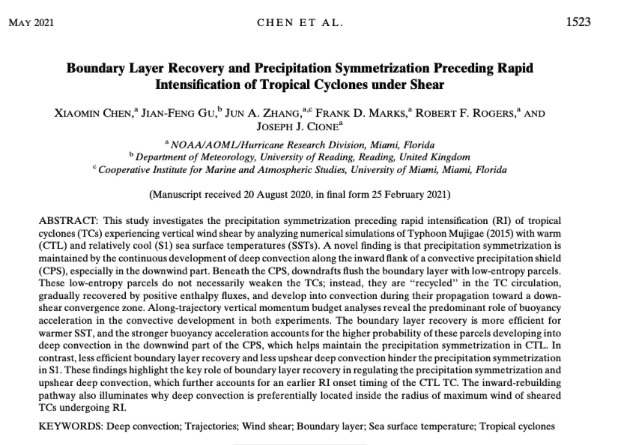Tropical Cyclones (TCs) occur over warm water in the ocean, and this warmth and moisture is what feeds the engine that keeps the TC going. They are made up of thunderstorms, what we call deep convection, and within the convection, there are both convective updrafts and convective downdrafts. The temperature in the atmosphere goes down with height above the surface, and so does the humidity. So, these updrafts push warm, moist air upward, and bring dry, cool air downward toward the surface. If there is a lot of cool, dry air near the surface, the fuel for the TC can be cut off.
Because the wind surrounding the TC are different at the top and bottom of the TC, what we call vertical wind shear, the TC tilts over with height, and a convective precipitation shield (CPS), where much of the deep convection in the TC occurs, forms in the same direction as the tilt. The CPS can take on a comma-like shape, as seen in Fig. 1a. Before TCs undergo rapid intensification, this CPS often gets larger and covers more of the area around the TC center (Figs. 1b-c). Eventually, it completely circles the center in a process called precipitation symmetrization, and an eyewall, the most dangerous part of a TC, forms. Beneath the CPS, convective downdrafts bring cool, dry air into the area just above the ocean surface (the boundary layer), potentially cutting off the fuel for intensification. Despite this, rapid intensification still occurs. By performing computer simulations of a real TC over various sea surface temperatures, thus varying the amount of energy for the TC, this study investigates how that happens.

Important Conclusion:
- A new finding is that, before rapid intensification occurs, precipitation symmetrization is maintained by the continuous development of deep convection along the edge of the CPS closest to the TC center.
- The low-heat and low-moisture air beneath the CPS does not necessarily weaken the TC as was previously thought; instead, this air is “recycled” in the TC circulation, gradually gaining back heat and moisture from the warm ocean below, and developing into convection as it moves toward the inner edge of the CPS in what we call the inward rebuilding pathway.
- This recovery of heat and moisture is most efficient over warm water. Warmer, moister air is more likely to develop into convection, especially where the air is flowing toward and through the CPS and on the edge of the CPS closest to the TC center. Because this convection develops where the air is flowing toward the CPS, the convection covers a larger region around the center. Since it develops on the edge closer to the center of the TC, the convection (where the strongest wind occurs in what we call the Radius of Maximum Wind speed or RMW) gets closer to the center. Over cooler water, this process is slower, or doesn’t occur at all (Figs. 2b-c).
- The inward rebuilding pathway explains something that happens often in TCs rapidly intensifying when they are in an environment with shear: deep convection occurs inside the RMW.

Para más información, póngase en contacto con aoml.communications@noaa.gov.
The full text can be found here.
